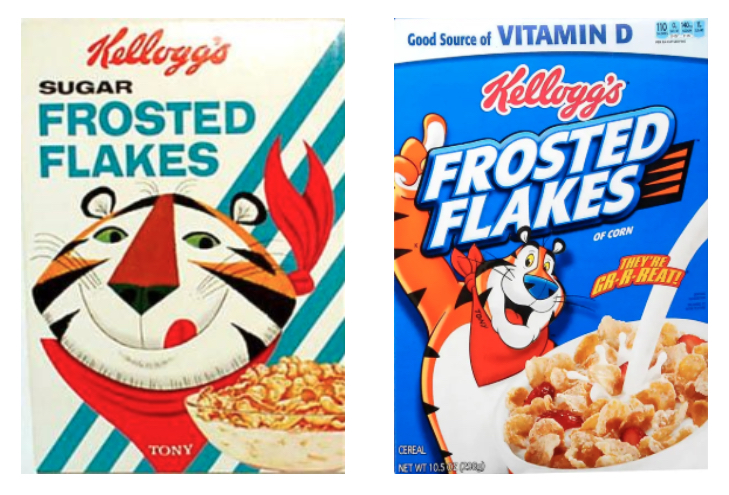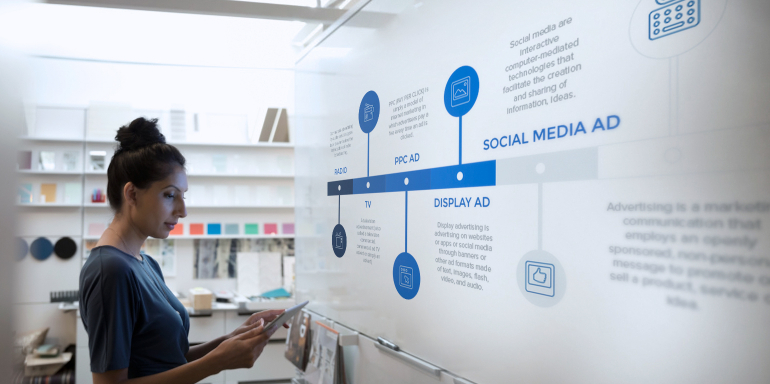The evolution of advertising has experienced some major milestones over the years, as it’s had to adapt and change to suit new mediums and audiences constantly. Most significantly, it’s become much more personalized throughout history. The one medium that’s had the biggest impact on the history of advertising and advertising personalization is the internet, and its ability to collect billions of data points on users.
For starters, Facebook alone has 98 personal data points on its 2.2 billion users, totaling 215.6 billion data points.
Even more impressive is Google. Between the company’s seven unique products with over 1 billion monthly active users each, Google collects enough personal data from its users over the course of one year to equal 569,555 sheets of paper. If printed and stacked, this would measure more than 189 ft. tall.
Starting with the pre-internet days, the timeline below shows how it has changed since the beginning. Then, a deeper look at how online advertising has completely revolutionized the practice in recent decades.
The evolution of advertising: the very beginning
Although the very first signs of advertising are said to date back to the ancient Egyptians’ steel carvings in 2000 BC, the first print ad was published in 1472 when William Caxton printed ads for a book and tacked them to church doors in England:

Fast forward to 1704, the first newspaper ad was published in the U.S.:

Then, in 1835, the first U.S. billboards displayed circus posters measuring over 50 sq. ft.:

Sears was the first company to focus more on personalization by advertising through direct mail. When they launched their massive direct mail campaign in 1892 with 8,000 postcards, it produced 2,000 new orders.
Then came the “Golden Age,” where advertising personalization began to take off even more...
The “Golden Age of Advertising”
Advertising became a whole movement when it came to radio and television in the early 1900s. Since it was speaking to people directly through their radios and TVs, it felt more personalized.
Advertising first hit the radio in 1922. Radio host H.M. Blackwell created his own “indirect direct” method -- a 10-minute talk about the virtues of living a carefree life at the Hawthorne Court Apartments in Jackson Heights, Queens. The cost for a 10-minute time slot was $50.
Personalization took another big leap in 1930 when Rosser Reeves introduced the idea of a unique selling proposition. Since a USP (aka unique value proposition) describes how your business will solve a customer’s problem, it should be very specific and highly personalized to differentiate your brand.
In 1935, George Gallup introduced market research -- gathering information about consumers to better relate and advertise to them.
The next major milestone in the evolution of advertising timeline came on July 1, 1941, when the first legal and continental commercial popped up on TV screens on WNBT. Although this Bulova Watch Company ad was brief (only a 10-second spot for a simple graphic and voiceover):
…it set the precedent for the next 70 years.
TV viewers began to feel optimistic, despite the 50s being tense for America during the Cold War. They started opening their wallets more as prosperity began to rise again -- and a large part of this was due to a change in advertising tactics (not just mediums). This was called the “Golden Age of Advertising” -- a time of big ideas and huge personalities during the 1960s through the late 1980s.
Companies began building characters around their products to establish more of a connection between viewers and brands. Tony the Tiger for Frosted Flakes, or the Snap, Crackle, and Pop gnomes for Rice Krispies -- both of which are still seen on cereal boxes today:

Famous faces, like the Marlboro Man from the 1960s to 1990s, were also often used to sell products:

Among all the different characters that emerged, the ads at this time had one main purpose: to sell. While the characters played a major part in creating an ad culture for consumers, the product was always at the forefront.
That is until online advertising came about, and with it came several major game-changers in the evolution of advertising and personalization.
Online advertising
This next period was known for introducing new channels and mediums and a drastic shift in motive. Rather than selling, the evolution of ads lead to a focus on brand awareness and problem-solving. What is the consumer’s problem, and how can the product solve it? Now the product was no longer the centerpiece of the ad -- the consumer was.
This all started when internet usage took off in 1992 with the introduction of online services like America Online and Prodigy. When everyone suddenly began using the internet for personal reasons, advertisers jumped all over the opportunity to reach consumers there. They began shifting their attention to more digital ads, starting with display advertising.
The evolution of display advertising began with the very first banner ad from AT&T in 1994:

About 44% of the people who saw the ad clicked it, and when they did, they landed here:

Although the page lacked any optimization, the ad set off a chain reaction that altered the course of the advertising industry, and banner ads caught on extremely quickly.
In 1995, Yahoo transformed itself from a web directory to a commercial business. The company announced an advertising deal for their own primitive banner ads, with five sponsor company logos rotating daily across the top of the site:

During this same year, Yahoo also created the first keyword-based ad.
The chain reaction continued into the next year when Planet Oasis launched the first version of PPC advertising, and Open Text began selling paid ads.
Mobile advertising came next, as mobile phones came into existence.
The evolution of mobile advertising
The first mobile ad showed up in 2000 when a Finnish news provider sent free news headlines via SMS. This led to more experimental mobile ads and mobile marketing initiatives down the road.
When the original iPhone was released in 2007, mobile advertising came to smartphones. However, still new to the medium, advertisers would simply reformat their desktop ads for mobile, meaning they weren’t well-designed and didn’t provide an ideal user experience. In response to widespread negative feedback from these first smartphone ads, advertisers began making their ads “mobile-first.”
The launch of the App Store in 2008 with the iPhone 3G allowed advertisers to take advantage of mobile app ads instead of mobile web browser ads. Then, as capabilities grew to include things like interactive gaming and GPS technology, mobile ads started incorporating these features for a more personalized and engaging user experience.
With the drastic evolution of online and mobile advertising, also brought challenges. Here’s a brief look at a few of them, along with the solutions that followed.
Digital advertising: challenges and solutions
Challenges
Lack of trust
Despite advertisers’ best efforts to appeal more to consumers with new methods and mentality, many viewers remain wary of advertisements. In particular -- pop ups, auto-playing videos, ads that push the main content below the fold, full-screen ads, ads that increase load times, and deceptive ads.
Research shows that Millennials are the most skeptical of ads. And since this is the first generation to grow up attached to the internet, social media, smartphones, tablets, laptops, etc., they have the most purchasing power and are the most important audience for many businesses.
Ad blockers
Audiences actively choose to avoid ads while they browse the internet. People will even pay if it means they can bypass sitting through ads. In 2015 alone, this cost publishers up to $22 billion in revenue -- a clear sign that advertisers needed to change their tactics.
Fortunately for advertisers, they have since developed ad formats and marketing strategies to combat ad blockers.
Solutions
User-generated content
Most consumers trust other consumers before they trust brands. Hence the rise of user-generated content. Essentially, consumers have become a part of advertising, rather than just passive onlookers.
This marketing strategy became especially popular when social media advertising began in 2008, starting with Facebook ads:

Consumers are much more likely to communicate their feelings over social media these days. They also communicate with one other far more than any ad campaign can communicate with them. For example, when evaluating a purchase, people often turn to friends and social networks to get additional opinions. That’s why it’s so important to build a community around your brand.
Facebook is perfect for this as it promotes user participation and engagement. When users find a product they show interest in -- they’re likely to share it, and then others tend to follow suit.
In the end, consumers want connectivity, trust, and assurance. They don’t necessarily want those from a brand. They want it from close, trusted sources -- and who’s more trustworthy than their own social communities?
Along with user-generated content and social media advertising, targeting options have also played a significant role in how digital advertisers reach prospects.
Targeting options
Advertisers today have billions of data points about consumers from Google and Facebook.
Over the course of one year, Google collects enough personal data from its users to equal 569,555 sheets of paper. If printed and stacked, this would measure more than 189 ft. tall. Google’s data points include:
- Location
- Apps used and websites created
- Searches and bookmarks
- Emails, contacts, and calendar data
- Google Drive files
- Google hangout sessions
- YouTube videos
- Photos taken on your phone
- Music listened to
Facebook alone has 52,000 data points, including:
- Every message you’ve ever sent or received
- Likely interests based off things you’ve liked and commented on
- Stickers you’ve sent
- Every time you log in, where you logged in from, what time, and from what device
- Every app you’ve ever had connected to your account
- Access to your webcam and microphone at any time
- Phone contacts, emails, calendar, call history, messages, downloaded files, games, photos and videos, music, search history, browsing history, etc.
With so many data points available to advertisers, they’re able to create extremely targeted and personalized ads. Case in point, this one from Marvel Universe Live, who knows my geographical location and family make-up (mom of two boys):

Hyper-targeting is critical because if digital advertisers can access data points like these, but also birthdays, marital status, family composition, occupation, type of car owned, etc. -- then the ads people see will be more relevant to them.
The evolution of advertising includes the post-click stage
Advertising has experienced many changes from the ancient Egyptian etchings to print ads, to the Golden Age, to today -- where highly-targeted, personalized online ads are the only way to succeed in today’s marketing world.
Show ads and promote ideas that people want to see and hear. Because the more people don’t see your content as an “ad,” the more they’ll be attracted to it, engage with your brand, and eventually purchase.
The ad click isn’t the end goal, though. After optimizing the pre-click stage, the post-click stage must match it. Get the most of your post-click marketing optimization opportunities, sign up for an Instapage Enterprise demo today.

Increase your conversion rates today
Schedule a product demo to learn more.
